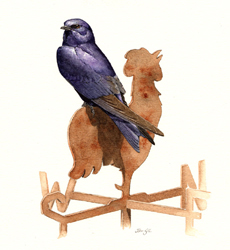Breeding Bird Atlases (BBA)
Find a Bird - BBA1
Breeding Bird Atlas 1 Species Accounts
Purple Martin
Progne subis
Egg Dates
May 30 to July 10
Number of Broods
one; may re-lay if first attempt fails.

This largest of the swallows is an uncommon to locally common breeder; it is uncommon as a migrant in Massachusetts. Purple Martins are insectivorous, communal birds that are most common in Massachusetts in the vicinity of salt marshes, coastal farmland, and golf courses. They nest exclusively in multichambered nest boxes or hanging gourds, but their occupancy is dependent upon a strict maintenance regime that keeps the boxes in good repair and prevents House Sparrows and European Starlings from usurping the site. Successful boxes share several characteristics—open space in the immediate area, water close by, wires or dead trees to perch on, and a human steward to oversee the colony.
Though some colonies are well established, the species has had a history of fluctuating populations in Massachusetts. They were always absent from the heavy forests that characterized the precolonial period. Historically, small numbers of martins probably inhabited the larger river valleys and coastal marshes. They then became locally common, nesting throughout much of southern New England in the mid- to late 1800s; but by the turn of the century their numbers declined drastically. A major factor affecting Purple Martin numbers and distribution is weather; a wet, cool, nesting season or a storm soon after the arrival of the breeding birds can wreak havoc on the population. In 1903, a cold, wet spell in April decimated the local population, and numbers have never again reached the pre-1903 levels. Severe competition for nest sites from starlings and House Sparrows has also taken its toll, and loss of habitat has probably further contributed to the decline.
During the Atlas period, the Purple Martin was unrecorded as a breeder from all of inland Massachusetts. The last Worcester County nesters, a little-known colony in Southbridge, persisted through the 1960s but disappeared in the early 1970s, when the nest house was removed (Meservey). The locations of successful martin colonies are along portions of the North Shore, South Shore, and coastal plain of southeastern Massachusetts, including scattered sites on Cape Cod and Martha’s Vineyard. To the north, the Parker River National Wildlife Refuge and vicinity are strongholds. To the south, small colonies are located in Wareham, Lakeville, Halifax, Hanson, Marshfield, and Middleboro. These latter colonies are on private land and are seemingly more likely to have populations that fluctuate than the colonies on the refuge. Away from these areas, martin houses placed in seemingly ideal locations and appearing to satisfy all breeding requirements are usually neglected. The small numbers (about 300 pairs) and dependency on humans make the future of the Purple Martin in Massachusetts uncertain.
Purple Martins begin to arrive in April and are well established at colonies by late in the month. The migration route from their South American wintering grounds is through Central America and north through the southern United States. Although martins arrive in April, breeding does not commence for more than a month.
The birds have a variety of guttural, chattering notes. When alarmed, they give a distinctive kerp-kerp call. Male songs are a series of low notes followed by a sort of trill. Originally, nests were built in tree and cliff cavities. Now both members of a pair line a nest box compartment with grasses, leaves, twigs, and feathers. Clutches consist of three to eight (usually four or five) pure white eggs. Two nests from Middleboro contained five and six eggs, respectively (Anderson). Egg laying typically occurs in early June.
One brood is raised each season, but the birds will often renest if the first attempt is unsuccessful. The hatch date for a known second nest attempt was July 10 (Anderson). Incubation by the female lasts about two weeks, sometimes slightly longer. The young can fly in about four weeks but sometimes fledge prematurely due to extreme heat and nest parasitism. Mortality among premature fledglings is high. Nestlings have been reported from June 21 to July 24 and recently fledged young from July 10 to August 12 (Anderson, Turner). Fledglings may return to the nest at night for a week or more.
Adults and young range widely before departing on migration, but during this postbreeding period they usually return nightly to established communal roosts, which may or may not be located near nesting areas. Due to the small breeding population in Massachusetts, such roosts are inconspicuous and poorly known, although there is a patch of Norway Spruce in Newbury that is regularly used as a premigration roost by martins, presumably from the Parker River National Wildlife Refuge colony.
Martins depart early from Massachusetts, generally during August, and September sightings are unusual. The wintering grounds are located in the Amazon basin of Brazil.
Map Legend and Data Summary
Atlas 1 data collected from 1975-1979


Note: locally common in southeastern section and at Plum Island; irregular on Cape Cod
David E. Clapp



